Posts Tagged ‘Maltese’
-
A MATTER OF FATE
For British diplomat John Hookham Frere, January became a month of sorrows….
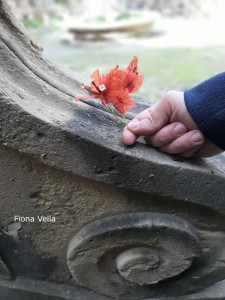 Some say that bad luck isn’t real and that there is no such thing as luck. Yet others would strongly avoid walking under a ladder or crossing the street in the presence of a black cat. They will certainly not open an umbrella indoors or drink any water that reflects moonlight, in the fear of attracting misfortune. Still, there are those who insist that whether you see it as lucky or unlucky, the chance event is the same. But is it?
Some say that bad luck isn’t real and that there is no such thing as luck. Yet others would strongly avoid walking under a ladder or crossing the street in the presence of a black cat. They will certainly not open an umbrella indoors or drink any water that reflects moonlight, in the fear of attracting misfortune. Still, there are those who insist that whether you see it as lucky or unlucky, the chance event is the same. But is it?John Hookham Frere, a British diplomat, poet, scholar and philanthropist, is not known to have spoken of bad luck. However, when years went by and he started to suffer the loss of his loved ones all during the same month, he lamented that January was becoming too melancholic for him.
Rumours say that his mother Jane, daughter of John Hookham (senior) who was a rich London merchant, had brought an astrologer’s silver cup as part of her marriage dowry. This cup originally belonged to her great uncle, John Dee, who was believed to be a conjurer. Legend said that he had used the cup to make some supernatural experiments but she insisted that this was not true. In defiance, she used the cup as a sugar bason.
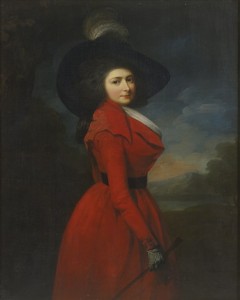 Curiously, the ‘January calamity’ had already struck the woman that Frere would eventually marry – Elizabeth Jemima Blake. A portrait painted by Sir Martin Shee shows her as a very beautiful girl with large dark eyes and masses of dark hair. In January 1790, she married George, sixteenth Earl of Erroll, who committed suicide in June 1798 after he confided an official secret to a friend who then published the communication and its author.
Curiously, the ‘January calamity’ had already struck the woman that Frere would eventually marry – Elizabeth Jemima Blake. A portrait painted by Sir Martin Shee shows her as a very beautiful girl with large dark eyes and masses of dark hair. In January 1790, she married George, sixteenth Earl of Erroll, who committed suicide in June 1798 after he confided an official secret to a friend who then published the communication and its author.The childless and beautiful widow met Frere in the year 1800 when she was recommended to stay in Lisbon to alleviate her mourning sorrows. At the time, Lisbon was a favourite health resort and Frere, who had just been appointed Envoy to the Court of Lisbon, was requested by a common friend to take care of her. Soon, the two became very good friends and along the years, they kept in contact through letters. Eventually, they got married on the 12th September 1816.
Lady Erroll never regained her health completely and this was a constant source of anxiety to her husband. A severe cold which she got while visiting the new rooms that were built at the British Museum for the Elgin marbles, wrought permanent damage to her constitution. A serious illness in 1820 obliged Frere to take her abroad and although she recovered some strength while travelling in the Mediterranean, it was clear that she would not survive the cold English climate.
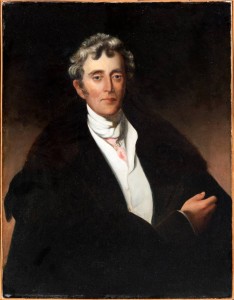 Since Frere preferred to live among English subjects, he chose to move to Malta. His sister Susanna, who had never married and who offered to help him to take care of his wife, joined them too. Initially, they resided in Casa Correa, a palatial building in Old Bakery Street, Valletta. Later on, they moved to Pietá, where they acquired two adjoined buildings, so that Susanna could live close by. This house on the waterfront helped Elizabeth to recover to better health and Frere began to show interest in the Maltese Islands which were so rich in history.
Since Frere preferred to live among English subjects, he chose to move to Malta. His sister Susanna, who had never married and who offered to help him to take care of his wife, joined them too. Initially, they resided in Casa Correa, a palatial building in Old Bakery Street, Valletta. Later on, they moved to Pietá, where they acquired two adjoined buildings, so that Susanna could live close by. This house on the waterfront helped Elizabeth to recover to better health and Frere began to show interest in the Maltese Islands which were so rich in history.Frere was very proficient in languages, namely Greek, Latin, Italian, French and Spanish. In Malta, he extended his knowledge in the Maltese and Hebraic languages. His ample library filled with prestigious and rare books became renowned with scholars, some of whom came to visit from abroad. At this time, he met Mikiel Anton Vassalli, a Maltese writer, linguist and philosopher.
Vassalli was expelled from Malta a number of times due to his political beliefs. His troubled life led to much difficulties and Frere helped to alleviate some of his problems. He financed the education of his three sons, supported him to publish his books and helped him to start teaching at the University of Malta as the first Professor of Maltese language. Frere’s remarkable kindness persisted even after Vassalli’s death, on 12th January 1829, when he took the responsibility of his burial in the then Protestant cemetery of the Msida Bastion, after the Catholic Church refused to do so due to his alliance with the Protestants.
Almost two years later, Frere had to return to these burial grounds again, this time to bury his wife when she passed away on 17th January 1831. His wife’s loss overwhelmed him with grief but he refused to return to England even though his relatives and friends advised him to do so. Eventually, he decided to acquire the steep hill behind his house in Pietá, turning the landscape into a set of lovely fertile terraces that were embellished with refined temples. From these peaceful gardens, he could look out at the cemetery where his beloved was resting.
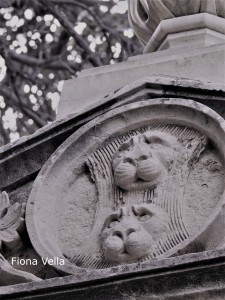 Yet the ominous month was set to claim another victim, this time his sister Susanna who died on the 18th January 1839, eight years and a day following the demise of his wife.
Yet the ominous month was set to claim another victim, this time his sister Susanna who died on the 18th January 1839, eight years and a day following the demise of his wife.In some letters which Frere wrote to his relatives and friends, he expressed his regret that the penalty of a long life was to see all those whom he had loved wither away and die. While his earlier years had been dedicated to political writing and literary satires, he passed the last years of his life composing epitaphs.
Instead of bringing an elation of joy at the beginning of a new year, January became acutely associated with death and Frere simply hated it. Who could have told him that this month would ultimately also claim his life – on 7th January 1846.
Currently, Heritage Malta holds the title for the iconic gardens of Villa Frere in Pietá. In February 2019, Heritage Malta and the NGO Friends of Villa Frere, signed a partnership and management agreement for the promotion, public availability, and the running and operation of the historical site.
The gardens of Villa Frere are opened for the public once a month or by appointment for groups. For further information, contact the NGO Friends of Villa Frere on Facebook or by email on villafrere@gmail.com
(This feature was published in the SENIOR TIMES – JANUARY issued with the Times of Malta dated 24 January 2020)
-
LIGHTS OUT FOR CHRISTMAS
Christmas time and the days preceding it are generally associated with colour, light, optimism and fun. Yet this was not the case in 1939 when the Christmas season became synonymous with gloom, darkness, uncertainty and fear.
On 18 September 1939, a table showing the duration of the ‘Official Night’ was published in Government Notice No. 459 in The Malta Government Gazette. This table included each day of each month and the beginning and end of what was to be considered as the official night hours. Such instructions formed part of the Malta Defence Regulations, 1939, which aimed to protect the Maltese Islands and its inhabitants as World War II ravaged in other countries.
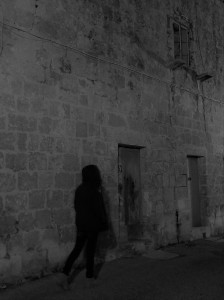 Two days later, on 20 September 1939, Government Notice No. 473 issued the Lights Restriction Order which was effective from that day. The directions of this Order had to be observed between midnight and 4:30am on every day of the week, and also between 10:00pm and midnight on Fridays. During these times, all lights in any building had to be masked to be invisible from the sea and from the air. No lights, other than lights authorised by the competent authority, were permitted in any open spaces whether private or public, in yards, roofs or open verandas. The use of illuminated lettering or signs in any shops were prohibited unless authorised by the Commissioner of Police or the competent authority. The traffic of motor vehicles during these hours was banned and any vehicles which did not comply with these provisions could be stopped and detained until 6:00am. Obviously, all fireworks were also prohibited.
Two days later, on 20 September 1939, Government Notice No. 473 issued the Lights Restriction Order which was effective from that day. The directions of this Order had to be observed between midnight and 4:30am on every day of the week, and also between 10:00pm and midnight on Fridays. During these times, all lights in any building had to be masked to be invisible from the sea and from the air. No lights, other than lights authorised by the competent authority, were permitted in any open spaces whether private or public, in yards, roofs or open verandas. The use of illuminated lettering or signs in any shops were prohibited unless authorised by the Commissioner of Police or the competent authority. The traffic of motor vehicles during these hours was banned and any vehicles which did not comply with these provisions could be stopped and detained until 6:00am. Obviously, all fireworks were also prohibited.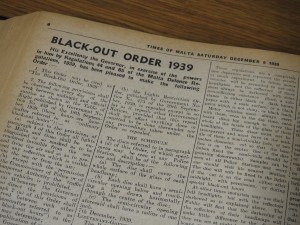 An Air-Raid Precautions Order was communicated in Government Notice No. 504 on 4 October 1939. Eventually on 9 December 1939, The Times of Malta published the provisions of The Black-Out Order, 1939, which had to be observed on every day of the week between midnight and the official sunrise. During these hours, all the lights on the Islands had to be extinguished or masked as to be rendered invisible from the sea and from the air. Special Black-Out hours could also be determined when necessary.
An Air-Raid Precautions Order was communicated in Government Notice No. 504 on 4 October 1939. Eventually on 9 December 1939, The Times of Malta published the provisions of The Black-Out Order, 1939, which had to be observed on every day of the week between midnight and the official sunrise. During these hours, all the lights on the Islands had to be extinguished or masked as to be rendered invisible from the sea and from the air. Special Black-Out hours could also be determined when necessary. As part of the Black-Out Order, from 14 December 1939, all motor vehicles which had to travel at night, other than those belonging to His Majesty’s service, had to have their bulbs removed from their lamps. Opaque cardboard discs were to be fixed to the lights of the vehicles and the reflectors’ surface had to be covered with a non-reflecting substance. A white disc had to be affixed at the back of all motor vehicles at a height of three feet from the ground to make them visible on the roads. Traffic of motor vehicles during the black-out was prohibited except for those who obtained permission from the Commissioner of Police or a competent authority.
Another notice which appeared on The Times of Malta of the 9 December 1939 urged the inhabitants to comply with these regulations for their own safety. People were recommended to stay at home and to avoid going out in the darkness. Those who needed to get out were advised to walk on the right-hand side of the road to face oncoming traffic and to carry with them a white object to make them more visible to drivers. Owners of goats were informed to keep their animals off the road at night. On the other hand, drivers were cautioned to drive very slowly and with great care.
Measures were being taken to prepare the people how to take the necessary precautions in preparation of an expected war. Black-outs intended to prevent crews of enemy aircraft from being able to identify their targets by sight. Nonetheless, these precautionary provisions proved to be one of the more unpleasant aspects of war, disrupting many civilian activities and causing widespread grumbling and lower morale.
The Times of Malta of 13 December 1939 reports that some misapprehension had arisen among that section of the public who had to rise early for work and travel by early buses, since it was not clear at what time the bus service started. Indeed, all buses were to continue their usual service provided that they adhered to the regulations regarding headlights and lights, including the inside of the vehicles which had to remain in darkness.
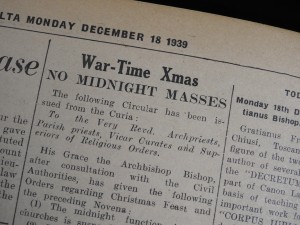 Even though the Maltese Islands were not yet directly involved in war, a foreboding atmosphere crept its way into the lives of people. As if matters were not yet miserable enough, a Bishop’s Circular which was published on The Times of Malta of 17 December 1939 declared that the Christmas midnight function in the churches was to be suspended. The Novena and feast functions could be celebrated from 4:00am onwards provided that no lights were visible from the outside. Those churches which required singers and musicians from far places for the early Christmas function had to apply to the Commissioner of Police for the necessary permits to travel. While it was permissible to give a small sign to the faithful by the ringing of bells for the function of the Novena and Christmas Eve, this had to be done according to predetermined rules.
Even though the Maltese Islands were not yet directly involved in war, a foreboding atmosphere crept its way into the lives of people. As if matters were not yet miserable enough, a Bishop’s Circular which was published on The Times of Malta of 17 December 1939 declared that the Christmas midnight function in the churches was to be suspended. The Novena and feast functions could be celebrated from 4:00am onwards provided that no lights were visible from the outside. Those churches which required singers and musicians from far places for the early Christmas function had to apply to the Commissioner of Police for the necessary permits to travel. While it was permissible to give a small sign to the faithful by the ringing of bells for the function of the Novena and Christmas Eve, this had to be done according to predetermined rules.Albeit the continuous warnings and pleas to adhere strictly to the black-out orders, it seemed that not everyone was following the rules. An announcement on The Times of Malta of the 20 December 1939 issued by the Lieutenant’s Government Office advised the public that the black-out on the night of December 15-16 was not entirely satisfactory, and that there were several lights showing in the Valletta, Sliema, Hamrun, Cospicua and Naxxar districts. Several lights were only put out as aircraft passed overhead. This notice pointed out also that a section of the public could still have been unaware of the black-out rules since they seemed to have been published only on The Times of Malta and Il-Berqa newspapers. Illiterate persons would therefore have had no way of being forewarned except by hearsay. Therefore, a siren warning which was different from the Air-Raid alarm signal, was recommended to be given throughout the islands at sunset.
Letters by readers in the Correspondence section of The Times of Malta of the 20 and 21 December 1939 vent their frustration and contempt at those who were not taking these black-out precautions seriously:
“Many people rather irresponsibly remark that they do not quite see the use of strict black-outs when Germany is at such a distance away. The reply is that precaution is better than cure. I am sure that these people will think very different if they find one day a German bomb dropping at their door-step or in their backyard, just because some stray lights guided an enemy to an objective.” Signed ‘Common-Sense’.
“I am sure that a number of law-abiding citizens in these islands feel that the time has come for coercion to replace coaxing. Those people who scorn to comply with reasonable regulations are either knaves or fools and most dangerous to the community in war time; they should be under lock and key for the duration of the war: either in jail or in a lunatic asylum. The pathetic appeals made by the authorities are becoming nauseating.” Signed Lieutenant Colonel (retired) H. M Marshall.
 Special Black-Out arrangements for Christmas and New Year, published on The Times of Malta of the 23 and 30 December 1939, informed the public that the black-out of buildings on the nights of 24 – 27 December and 30 December – 1 January were to be postponed for one and a half hours from midnight. On these nights, motor vehicles were allowed on the road without requiring special permission until 1:30am, and shops and places of entertainment could remain open until 1:00am.
Special Black-Out arrangements for Christmas and New Year, published on The Times of Malta of the 23 and 30 December 1939, informed the public that the black-out of buildings on the nights of 24 – 27 December and 30 December – 1 January were to be postponed for one and a half hours from midnight. On these nights, motor vehicles were allowed on the road without requiring special permission until 1:30am, and shops and places of entertainment could remain open until 1:00am.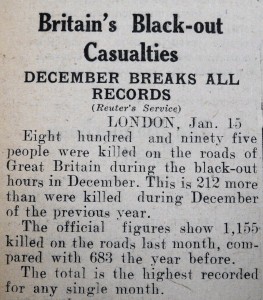 Possibly few had considered that light could be their enemy until it became essential to extinguish it. There was no mention of accidents or fatalities due to the black-out on the Islands in the December’s Times of Malta newspapers. However, reports from Great Britain relating to the high increase in road fatalities during the night were quite shocking. On 13 December 1939, the British Official Press stated that road fatalities had increased considerably from September to November. Yet the worst scenario took place in December, as reported by the Reuter’s Service on 16 January 1940, when 895 people were killed on the roads of Great Britain during the black-out hours. This was 212 more than those who were killed during December of the previous year.
Possibly few had considered that light could be their enemy until it became essential to extinguish it. There was no mention of accidents or fatalities due to the black-out on the Islands in the December’s Times of Malta newspapers. However, reports from Great Britain relating to the high increase in road fatalities during the night were quite shocking. On 13 December 1939, the British Official Press stated that road fatalities had increased considerably from September to November. Yet the worst scenario took place in December, as reported by the Reuter’s Service on 16 January 1940, when 895 people were killed on the roads of Great Britain during the black-out hours. This was 212 more than those who were killed during December of the previous year.This was surely a strange Christmas to the Maltese people who are accustomed to celebrate these days in a profuse way. Although through no fault of their own, they were involved in war and they had to adapt to war conditions. Alas, much worse was yet to come.
(This article was published in the Christmas Times magazine issued with The Times of Malta dated 13 December 2017)
-
Take me to church
“ ‘They have hit our church!’ cried a man as he stumbled down in the tunnel which was located under the Mall Garden. We were huddling in there for shelter together with many other people as the bombs came down over Floriana,” reminisced Pawlu Piscopo who was eight at the time.
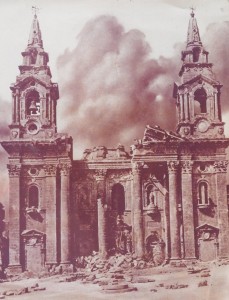 “At this horrible news, my father grabbed me and my brother by the hand and took us out of the tunnel and over to the granaries where a very sad spectacle awaited us. St Publius’ Church had suffered a direct hit. Its dome was gone and the area was surrounded in rubble. Thirteen people who were taking cover in the church’s crypt were killed and eleven more were injured. That was the blackest moment in the history of the parish church of Floriana: April 28, 1942 at 7:50am.”
“At this horrible news, my father grabbed me and my brother by the hand and took us out of the tunnel and over to the granaries where a very sad spectacle awaited us. St Publius’ Church had suffered a direct hit. Its dome was gone and the area was surrounded in rubble. Thirteen people who were taking cover in the church’s crypt were killed and eleven more were injured. That was the blackest moment in the history of the parish church of Floriana: April 28, 1942 at 7:50am.”After their house had been bombed, Pawlu’s family were allowed to take some respite in a large residence which today houses the Floriana Local Council. Yet for four years, they lived mostly underground in this tunnel which probably saved their lives. They took with them only a few belongings and the most cherished items, including a statue of St Publius which dated back to 1928 and used to adorn the model altar that his father had constructed at home.
“Most families in Malta had a model of an altar or a miniature church at home at the time. Unfortunately, many of these had to be abandoned during the war and a good number of them were destroyed when the houses were bombed.”
The craft of church model-making had been introduced to our islands by the Knights of St John back in the 16th century, and therefore its knowledge was a distinct tradition. However the adversity of war ravaged even this precious memory until eventually this craft was almost completely forgotten.
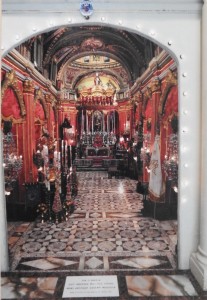 “After the war, people tried to get on with their lives as best as they could. Shops started to open again but those that used to sell miniature items with which to decorate our religious models, dwindled down to almost none. Nevertheless, the passion for model-making was much engrained in our family and when I bought a miniature structure made of four columns and a dome from a man who was leaving Malta to go to live in Australia, my father Carmelo was inspired to use it as the foundation for a model of St Publius’ church,” explained Pawlu.
“After the war, people tried to get on with their lives as best as they could. Shops started to open again but those that used to sell miniature items with which to decorate our religious models, dwindled down to almost none. Nevertheless, the passion for model-making was much engrained in our family and when I bought a miniature structure made of four columns and a dome from a man who was leaving Malta to go to live in Australia, my father Carmelo was inspired to use it as the foundation for a model of St Publius’ church,” explained Pawlu.Carmelo was a very skilled carpenter. He would go from time to time to have a look at the church and then go back to his model and construct an exact copy of the section that he had seen.
“He used the material which was handy at the time, mostly cardboard, wood and gypsum. I helped him out too in order to build the whole church which included ten altars. Eventually, this model reached a huge size of three by four metres and we could walk in it and look above at the beautiful dome,” Pawlu said proudly.
Once his father grew old, Pawlu continued with the work on this church which they had started back in the early 1960s. As he embellished this model, the wish to set up a group for model-makers in order to share this passion with them, burnt within him.
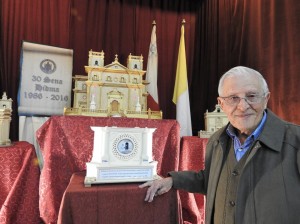 “On February 26, 1986 which happenned to be the tenth anniversary of my father’s demise, I discussed this idea with two of my friends, Raphael Micallef and Tony Terribile, who were very interested in this sector. We all agreed to do something in order to revive this craft and we sent out adverts in the newspapers to announce the set up of this group which we called Għaqda Dilettanti Mudelli ta’ Knejjes (Church Modelling Society). We were very happy when we received a great response from enthusiastic individuals all over Malta. Soon, a commitee was formed and on March 1986, we organized the first exhibition during the first two weeks of Lent wherein the members displayed the works that they had.”
“On February 26, 1986 which happenned to be the tenth anniversary of my father’s demise, I discussed this idea with two of my friends, Raphael Micallef and Tony Terribile, who were very interested in this sector. We all agreed to do something in order to revive this craft and we sent out adverts in the newspapers to announce the set up of this group which we called Għaqda Dilettanti Mudelli ta’ Knejjes (Church Modelling Society). We were very happy when we received a great response from enthusiastic individuals all over Malta. Soon, a commitee was formed and on March 1986, we organized the first exhibition during the first two weeks of Lent wherein the members displayed the works that they had.”It was certainly a great satisfaction to see this society thrive and grow along the years, always adding up new members of various ages. Today, around 400 members form part of this group which operates from its premises at 37, East Street, Valletta.
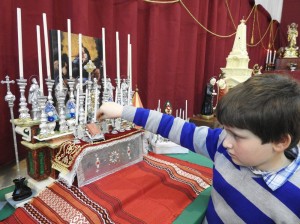 “This year we are delighted to celebrate the 30th anniversary from the establishment of this society,” Pawlu said. “The annual exhibition has been taking place each year. Besides offering the opportunity to showcase our members’ works, this event has served to help our members and the public which visits it, to meditate during the Lent period and to prepare for the Easter celebrations.”
“This year we are delighted to celebrate the 30th anniversary from the establishment of this society,” Pawlu said. “The annual exhibition has been taking place each year. Besides offering the opportunity to showcase our members’ works, this event has served to help our members and the public which visits it, to meditate during the Lent period and to prepare for the Easter celebrations.”A bi-monthly magazine, Il-Knisja Tiegħi (My Church), which was also initiated by Pawlu, is marking its 30th anniversary too. Members have been writing features in it related to different aspects of religious folklore, thereby kindling even further interest in model-making.
Once again this year, the society has organized this exhibition which saw the participation of several of its members. Exhibits varied and included small to large statues of the passion of Christ and Easter, statues of Blessed Mary and several saints, models of altars, church facades and whole churches made of different materials.
 “I hope that I’ll have enough strength to exhibit my large model of St Publius’ church,” revealed Pawlu at one point. “It takes me four weeks to set it up on a large platform and to connect the miniature chandeliers and light fittings to electricity. I am getting old now and such work is very tiring.”
“I hope that I’ll have enough strength to exhibit my large model of St Publius’ church,” revealed Pawlu at one point. “It takes me four weeks to set it up on a large platform and to connect the miniature chandeliers and light fittings to electricity. I am getting old now and such work is very tiring.”Pawlu has been exhibiting this model in a building besides the Floriana Cathecism Museum for many years now, during the feast of St Publius which takes place two weeks after Easter.
“Many people come to visit my model and they are fascinated with it. Tourists take photos besides it and they ask me how I managed to construct it section by section and yet making it look as a whole. I tell them that there are lifetimes of passion invested within it and that it is imbued with a blend of religious meaning and local traditional skills and creativity.”
At 82 years, Pawlu is serene and thankful to see the society which he has founded together with his friends strengthen itself and adding members to it.
“I just wish that it will continue to flourish for very long,” smiled Pawlu as he looked contentedly around him in order to appreciate the beautiful displayed works of the society’s members.
(This article was published in the Easter Supplement which was issued with The Times of Malta dated 21st March 2016)
-
A medal for silver
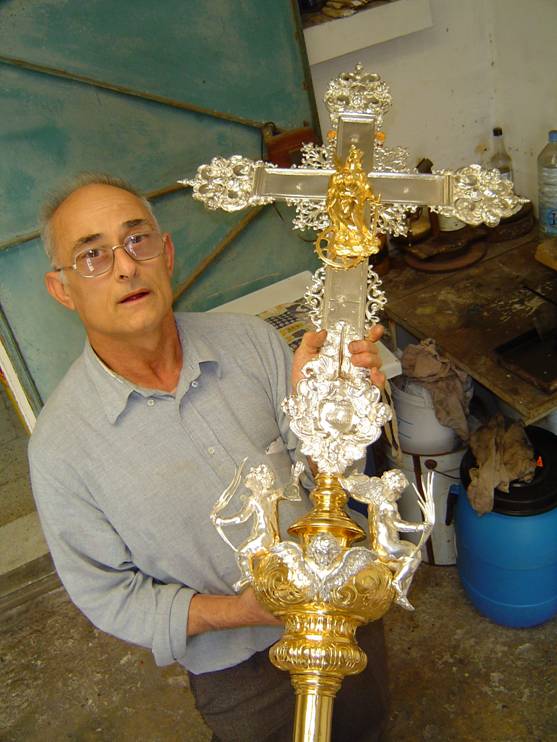
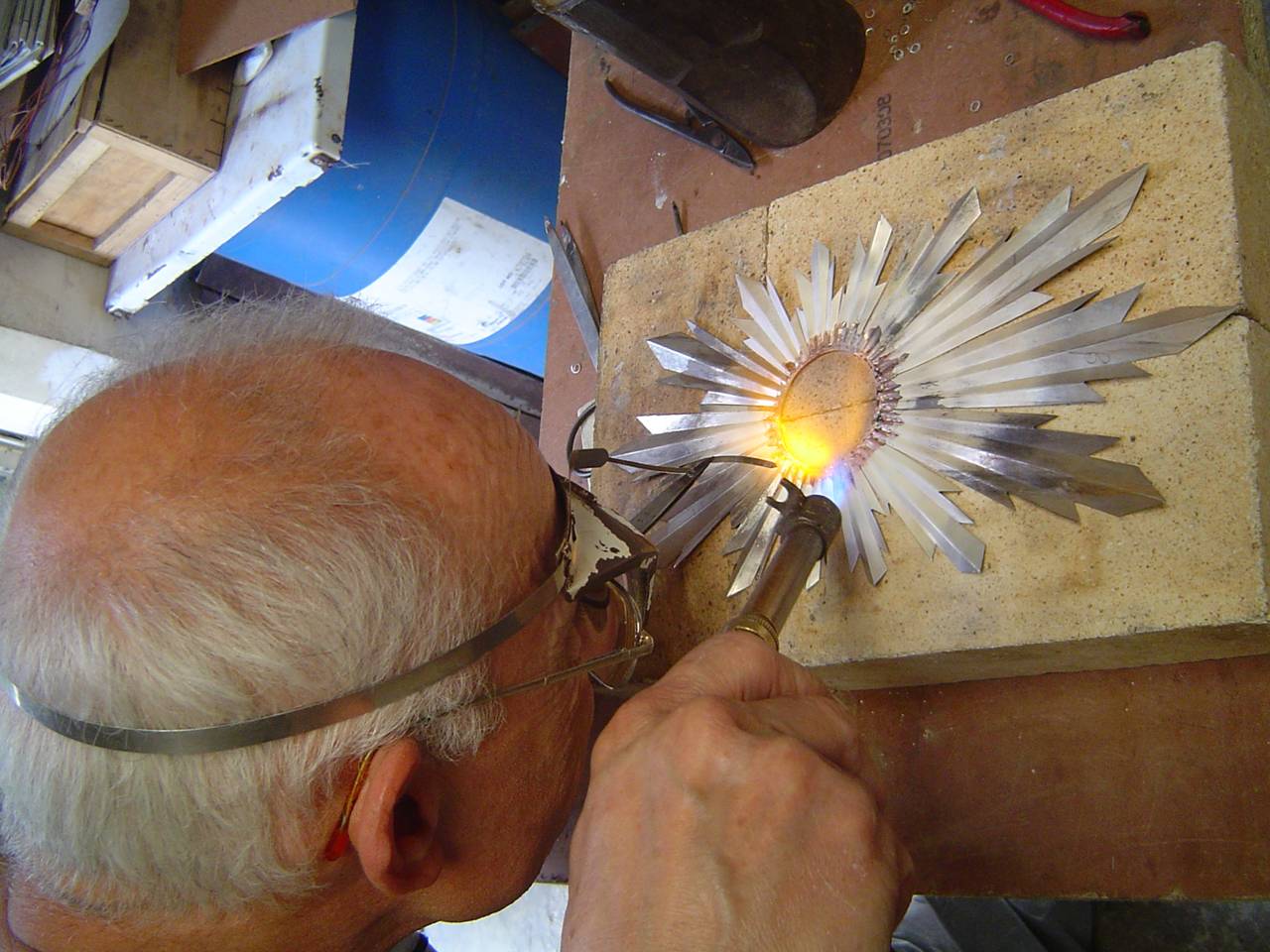
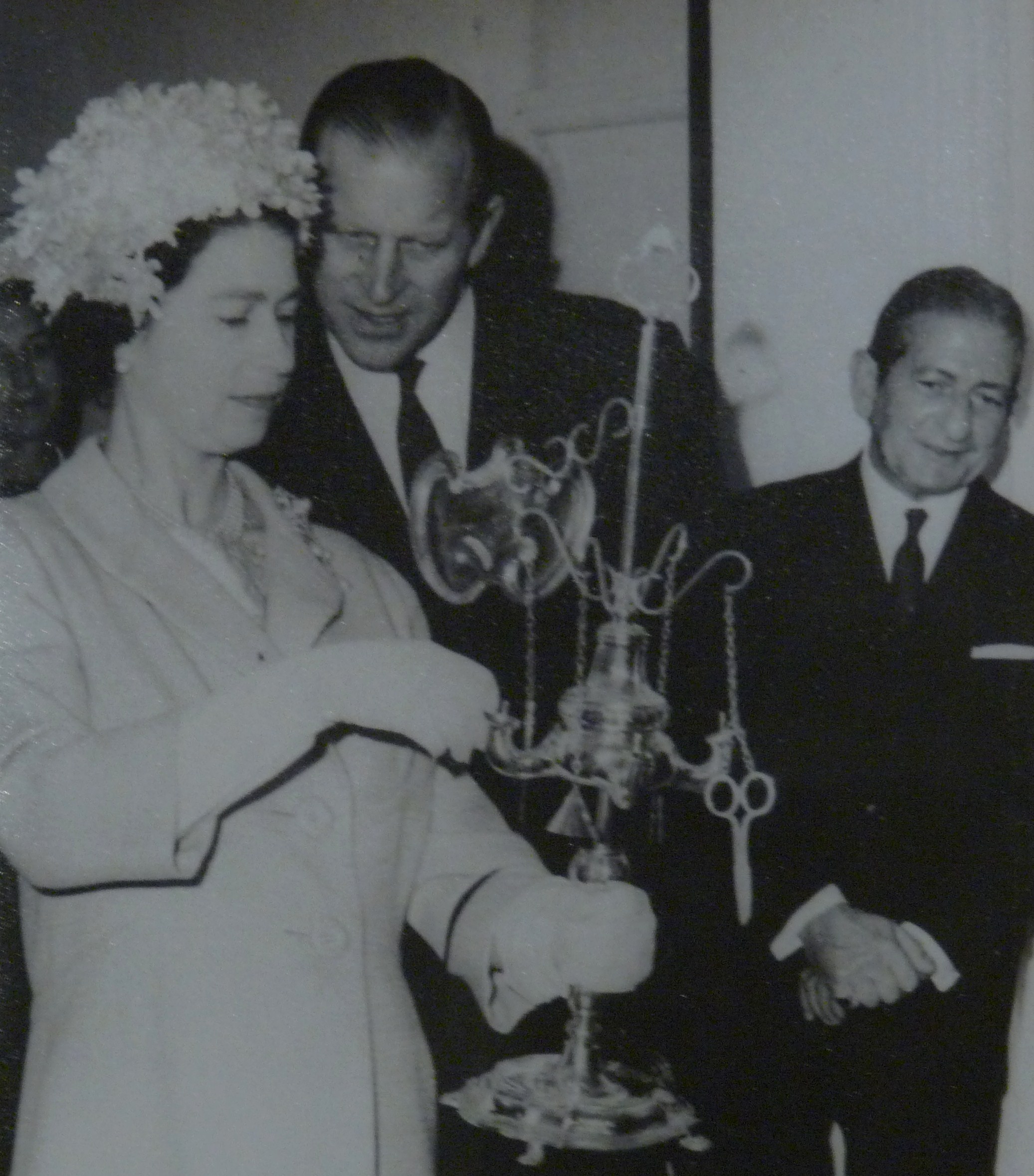
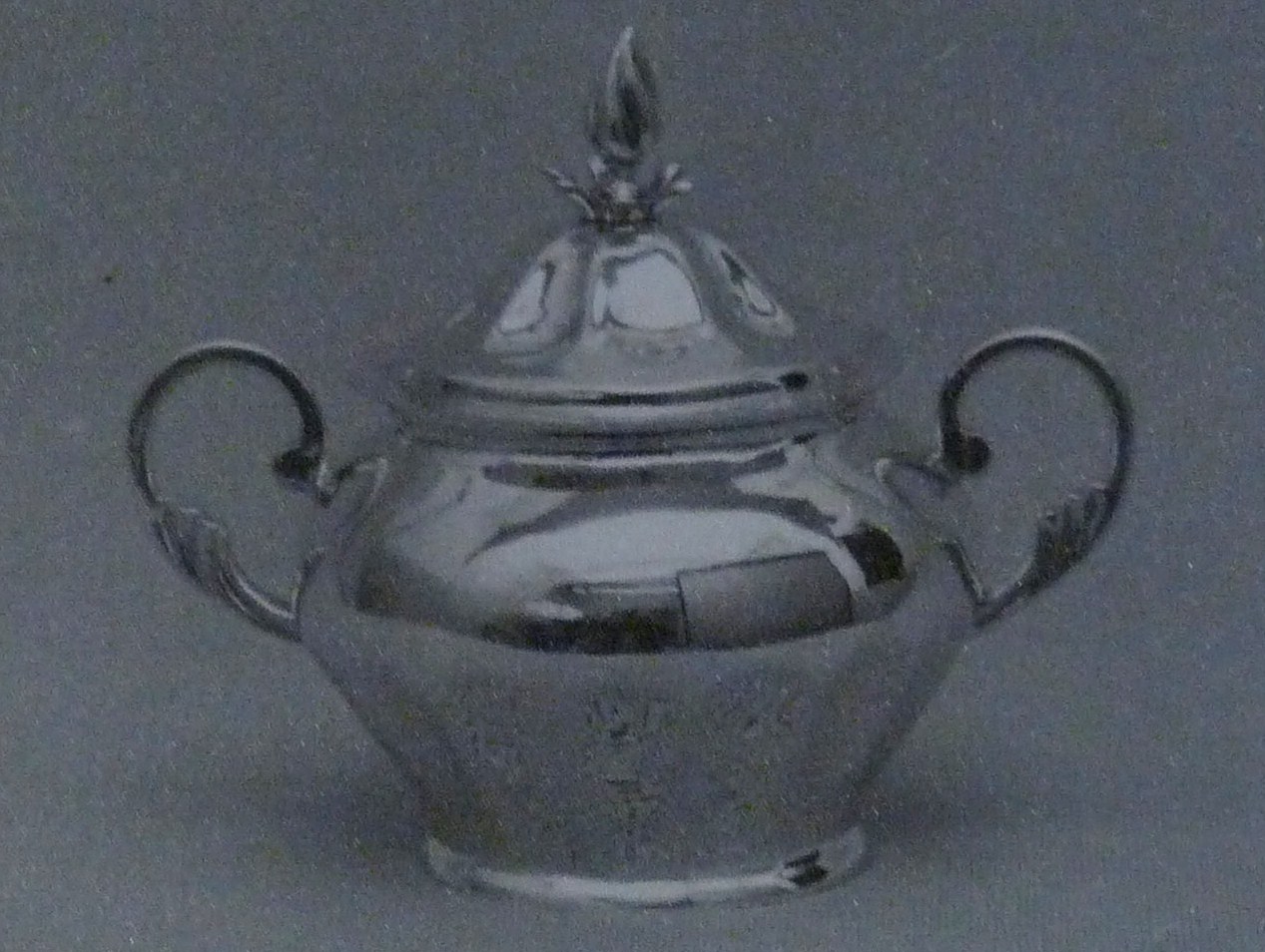
Within his small workshop in Zejtun, 68 year old silversmith Joseph Aquilina, can still do wonders with precious metals. Having worked as a silversmith from age 14, he has gained so much mastery in this trade that one of his creations was donated to Queen Elizabeth II during the celebrations of Malta’s Independence in 1964. Nowadays, his expertise is particularly focused on the restoration of antique objects which adorn our churches.
Aquilina learnt this trade from his father Joseph who was originally from Cospicua. Before World War II, Cospicua was renowned for some of the most skillfull silversmiths who eventually had to move to other areas in Malta when this zone became a target to heavy attacks and bombardments.
From early childhood, Aquilina was very interested in his father’s work and he spent hours observing him working silver items in his shop at St Mary Square in Zejtun. At age 12, he used to rush at the shop immediately after school in order to join silver beads together to produce rosaries for his father’s clients.
Aquilina knew that he was hooked to this trade but he never dreamt that at age 14, he would be obliged to choose between attending school and becoming a silversmith! It all happened when one day, a social service inspector called at their shop and found him doing some work. It was useless to insist that the boy was only helping his father because the inspector maintained that if the boy wanted to stay in the shop, he had to register for employment within 15 days. And that was the end of his schooldays.
“School meant nothing to me at that time and I thought that it was a great opportunity to start doing what I was really passionate about. However, when in later years I had to manage my business and was faced with several difficulties due to my brief education, I realized that leaving school at such an early age was definitely a huge mistake,” admitted Aquilina.
His father was greatly disciplined in his trade and he demanded the same diligence from his son. Above all, he wanted to pass to him all the knowledge that he had inherited from past generations. Yet this was no easy task since the silversmith’s trade expands vastly and covers areas which include work in silver, gold, filigree and the setting of diamonds.
“Nowadays, most silversmiths choose to specialize in just one of these sectors, but when I was learning the trade, one had to learn to deal with all these areas in order to become a professional. It took long years until you were regarded to be competent enough to open your own business. That was why it was necessary to start at a very young age in this trade and to take matters very seriously.”
Interestingly, Aquilina succeeded to attain his father’s complete trust by disobeying him.“My father expected utter attention during work, both because he wanted the final product to be impeccable, and also because the slightest mistake could be very costly, especially when we were using gold. He put so much pressure upon me that at first, I felt terrified of him and I did not dare to do anything which he did not ask for.”
Yet one day, Aquilina felt confident enough to try his luck by operating the soldering equipment which his father had adamantly prohibited him to use. Indeed, whilst his father went to church to attend a Lent sermon, Aquilina asked his mother to give him her gold wedding ring in order to cut it in half and reconstruct it again. His mother accepted without a second thought and Aquilina hurried to the workshop, broke the ring in two, switched on the gas, prepared the soldering equipment and trembling with excitement, he quickly joined the two parts together. He did such an excellent job that his mother could not identify any signs that her ring had been broken, and when she told her husband about this and he inspected the ring, a bright smile lit on his face. His son had finally made it!
From then on, Aquilina had his father’s complete respect and he started to produce his own creations for their clients. He had learnt this trade in the traditional way where everything was done by hand, and to keep in line with this method, he decided to focus on the antique style. This stratagem worked perfectly with those connoisseurs who appreciated refined local craftsmanship.
“I am proud to say that many of my works can be found among the collections of several local and foreign distinguished individuals. Most of my creations consisted of antique Maltese style coffee sets which included only three items: a coffee pot, a sugar-basin and a milk jug, since tea was not popular back then.”
Some of Aquilina’s works have often been selected to be given as gifts to foreign individuals.
“I made a particular silver sugar-basin for a group of Drydocks’ workers who wanted to give it to their British Admiral when he ended his job in Malta. Yet surely, the most popular item that I produced, was the 14 inch oil lamp which the Government of Malta ordered directly from me during the period of the 1970s and 1980s in order to consign it to the foreign delegations who visited our country.”
Meanwhile, even though throughout the years, there were many machines available which could ease the difficulty of the job and hurry the flow of work, Aquilina always refused to use them.
“That is the only way of keeping the profession’s prestige and the value of your creations,” Aquilina insisted. “When this type of work is done by machines, the product will loose all its significance because nothing can replace the creative fabrication of the human hand. A handmade product is unique because one can rarely create an object exactly like another. Contrarily, the very precision of objects which are executed by machines will simply turn them into ordinary copies.”
In order to design and work his particular creations, at times Aquilina had to manufacture his own tools. Yet apart from the ingeniousness required in order to assemble these devices, it was fascinating to know the stories behind the origin of some of the material.
“Look at these heavy hammers and feel how heavy they are,” he told me with a mischievous look as he brought them near. “I bet that no one would ever guess what they are made of until I tell them myself!”
Certainly, I did not have the slightest idea.
“These were some of the huge bolts that formed part of the ‘Angel Gabriel’; the Greek tanker which in 1969 got shipwrecked near the area of the ex-Jerma Palace Hotel in Marsascala. I obtained them when the ship was being broken down into pieces in order to clear the coast.”
Another curious fact about this trade is that whenever a new silversmith is authorized to start his/her business, he/she is given a personal stamp with which to mark each object that they make. This stamp will be unique and it cannot be transferred to another person. Therefore, each silversmith’s work can always be recognized, no matter how much time elapses.
In order to explain better, Aquilina referred to an old and rare book ‘The Goldsmiths of Malta and their Marks’ (1972) which was published by Chev Victor Fredrick Denaro; a pioneer in the study of ancient silver in Malta. In this book, one finds significant information about the ancient trade of silversmiths which goes back to the period of the Knights of St John. Meanwhile, this publication includes also all the local silversmiths’ stamps together with their relevant details; starting from the Knights period up to 1972.
“This book is very precious to me particularly because it helps me to identify the silversmiths of the antique objects which I work on. This will also determine the period of the objects’ manufacture with more precision, and thereby I can understand better which materials and which procedures were involved in its making,” explained Aquilina.
The restoration of antique metal objects requires high expertise and attention since one small mistake could ruin them completely. Indeed, in these last years Aquilina was responsible for the restoration of various treasured items which include: the restoration of the silver crown of the icon of the Madonna of Carafa that is located within the Co-Cathedral of St John in Valletta, the restoration of the silver leaves that form part of the decoration of the relic of St John the Baptist which is situated in the Museum of the same Co-Cathedral, and in the restoration of the sword of the titular statue of St Catherine in the Parish of Zejtun.
(This article was published in the ‘Art, Antiques and Restoration’ Supplement of The Times of Malta dated 12th November 2014)
-
ICH LIEBE MALTA
 A little train set ignited a passion for model building in a young boy of three…. Now forty, Rainer Mader reveals that the same passion has kindled an intense fascination for Malta and its culture, its history and its people.
A little train set ignited a passion for model building in a young boy of three…. Now forty, Rainer Mader reveals that the same passion has kindled an intense fascination for Malta and its culture, its history and its people.“It was Christmas and my parents gave me a wonderful model train set which consisted of a black locomotive with three green passenger cars and two other red cars. These model rail sets are very popular in Germany, especially with young children who are delighted and intrigued by the movement of the trains going round on the rails. However, these train sets are also a favourite with adults too who build large landscapes through which the trains can move. Eventually it can prove to be quite an expensive hobby.”
Sitting in the cosy lounge of Preluna hotel, Rainer explained how he ended up getting hooked on this hobby of model building.
 “I never stopped building models from then on, but when I joined the army, my interest turned onto military modeling. I prefer tanks, trucks and jeeps which I purchase as semi-assembled models. My finished models are around 10 cms and usually I finish them within one day. The most laborious work is the painting, as these models require to have a weathered used look and they actually need a lot of drying time.”
“I never stopped building models from then on, but when I joined the army, my interest turned onto military modeling. I prefer tanks, trucks and jeeps which I purchase as semi-assembled models. My finished models are around 10 cms and usually I finish them within one day. The most laborious work is the painting, as these models require to have a weathered used look and they actually need a lot of drying time.”Rainer admits that he has a rather impatient nature and that once he begins to work on a model, he would want to finish it as soon as possible.
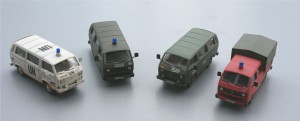 “I love this hobby because it gives me a rest from my work. Yet being very busy, I don’t have much time available to spend on a model and therefore I choose to work on semi-assembled ones. Nonetheless there are moments when I opt to convert a standard model in order to build a particular one which is not yet on the market. For example, we still have some special American trucks in Germany which are presently changing all the equipment with brand new staff. Now usually that would take about two to four years for the industry to provide an exact model of the new vehicle. So my aim would be to find a similar model of that truck and modify it accordingly in order to possess a small version of the new vehicle beforehand”.
“I love this hobby because it gives me a rest from my work. Yet being very busy, I don’t have much time available to spend on a model and therefore I choose to work on semi-assembled ones. Nonetheless there are moments when I opt to convert a standard model in order to build a particular one which is not yet on the market. For example, we still have some special American trucks in Germany which are presently changing all the equipment with brand new staff. Now usually that would take about two to four years for the industry to provide an exact model of the new vehicle. So my aim would be to find a similar model of that truck and modify it accordingly in order to possess a small version of the new vehicle beforehand”.His first glimpse of Malta back in 1999 was love at first sight…..
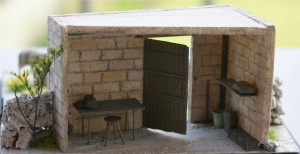 “Malta is totally different from where I live in Aschaffenburg, near Frankfurt in Germany. I remember that what impressed me most was the proximity of the sea. I love the sea… it’s beautiful crystal blue colour, it’s salty smell, and it’s ever changing sounds. It gives me a very pleasant feeling to hear it, smell it and see it everywhere around me here in Malta.”
“Malta is totally different from where I live in Aschaffenburg, near Frankfurt in Germany. I remember that what impressed me most was the proximity of the sea. I love the sea… it’s beautiful crystal blue colour, it’s salty smell, and it’s ever changing sounds. It gives me a very pleasant feeling to hear it, smell it and see it everywhere around me here in Malta.”His sister introduced him to some of her Maltese friends from Santa Venera and from then on, a long friendship was born where Rainer got to know better the Maltese people and their culture. His interest in Malta continued to grow even further once he discovered the local Association of Model Engineers and became a member there.
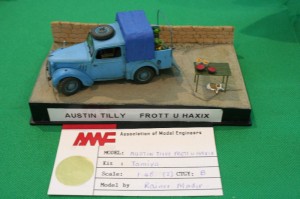 “The Association organizes an annual model exhibition and in these last five years, I have always participated with my models. Thanks to the AME I met many model enthusiasts and soon we became good friends. One can say that these exhibitions serve as a showcase of our hobby while at the same time they provide an opportunity to introduce and blend different cultures together. For example through these model exhibitions, the Maltese can experience a railway, whilst foreigners can get to know about some local customs.”
“The Association organizes an annual model exhibition and in these last five years, I have always participated with my models. Thanks to the AME I met many model enthusiasts and soon we became good friends. One can say that these exhibitions serve as a showcase of our hobby while at the same time they provide an opportunity to introduce and blend different cultures together. For example through these model exhibitions, the Maltese can experience a railway, whilst foreigners can get to know about some local customs.”In fact Rainer decided to surprise his Maltese friends by building diaromas which depict the local history and landscape.
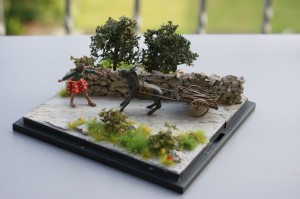 “Last year, I was flipping through the pages of a tourist magazine about Malta when I saw some old photos which instilled in me the desire to give them life through my diaromas. My first diaroma represented a van which sold vegetables and fruit. This year I made another two: one showing a woman trying to pull behind her an unwilling donkey, and another one which illustrates a sheperd with his sheep in his farm. These models were very much appreciated during the exhibition and in fact I won a gold medal”.
“Last year, I was flipping through the pages of a tourist magazine about Malta when I saw some old photos which instilled in me the desire to give them life through my diaromas. My first diaroma represented a van which sold vegetables and fruit. This year I made another two: one showing a woman trying to pull behind her an unwilling donkey, and another one which illustrates a sheperd with his sheep in his farm. These models were very much appreciated during the exhibition and in fact I won a gold medal”.Proudly Rainer showed me his dioramas while he tried to describe them in the Maltese language. Being a typical romantic Maltese, I could not help not appreciating this German’s effort to try to speak our language.
 “I realized that once you start to learn some Maltese, you will increase the possibility of making friends faster. My Maltese friends simply love hearing me speak their language and many of them try to teach me some new words. In fact, a friend of mine who works as a printer, has even printed a dictionary for me with German and Maltese words and the German phonetic way to say them in Maltese. I also bought some books which include CDs of Maltese words in order to learn better the language. By now, I can only speak basic words and sentences but I am adamant to learn more. At times, I find a Maltese word which I do not understand and I ask my Maltese friends to explain to me what it means. Then, each time that I visit again, I love to surprise them with some new expressions that I learn.”
“I realized that once you start to learn some Maltese, you will increase the possibility of making friends faster. My Maltese friends simply love hearing me speak their language and many of them try to teach me some new words. In fact, a friend of mine who works as a printer, has even printed a dictionary for me with German and Maltese words and the German phonetic way to say them in Maltese. I also bought some books which include CDs of Maltese words in order to learn better the language. By now, I can only speak basic words and sentences but I am adamant to learn more. At times, I find a Maltese word which I do not understand and I ask my Maltese friends to explain to me what it means. Then, each time that I visit again, I love to surprise them with some new expressions that I learn.”Cheerfully, Rainer admitted that he is also enthralled by the local food and drink. I was quite amazed when he listed the amount of cans of Cisk and Kinnie, and packets of galletti and Twistees that he takes back with him to Germany to enjoy with his friends. Thinking about it, I thought that maybe each time that he returns back to Germany, Rainer is trying to take a little part of Malta with him.
 “It is true! I came to love Malta and its people very much. In fact from 2003, I visit this island each year, my visits getting more frequent each time, so that now I come to Malta three times a year. Moreover, I have a little calendar at my place of work and while I am waiting for the machines to finish, I just flip its pages and have a look. When I exhibited last year’s diorama in a German exhibition, people were very curious about it and they asked me from where I got the idea for that landscape. So I explained to them about Malta and I showed them some books about the island. Somehow these dioramas are very special to me and I won’t part with them for anything else.”
“It is true! I came to love Malta and its people very much. In fact from 2003, I visit this island each year, my visits getting more frequent each time, so that now I come to Malta three times a year. Moreover, I have a little calendar at my place of work and while I am waiting for the machines to finish, I just flip its pages and have a look. When I exhibited last year’s diorama in a German exhibition, people were very curious about it and they asked me from where I got the idea for that landscape. So I explained to them about Malta and I showed them some books about the island. Somehow these dioramas are very special to me and I won’t part with them for anything else.”Naturally Rainer is very fond of the local villages which are most near to the sea like Dingli and Xlendi. He strongly resists the idea of a bridge from Malta to Gozo because he claims that it would surely ruin the scenery. He doesn’t like the modern Maltese architecture especially the never-ending apartments which are replacing, according to him, the lovely old houses such as those that up to some years ago, used to be on the Sliema seafront. Moreover he feels perplexed about the permits of huge establishments with not enough parking space inside.
“When you visit a country so regularly, you tend to become involved more closely to it and to its people. Actually I am also very interested in the local history especially from 1940 till now, particularly the Second World War period.”
At this point, I could not help asking…. Being a German who has Malta at heart so much, how does it feel to get to know about the participation of the Germans in this war in relation to our islands?
 “Surely I am not proud of this history but no one can do anything about it; that was war and thankfully it’s history! I do feel touched when I visit the Malta at War Museum and I see those underground shelters. However though grim and painful, I need to face this history as it also gives me more background for this hobby in model making. Certainly the merging together of different cultures through such activities will help people to relate better to each other, and to establish mutual bonding and respect that will prevent history from ever repeating itself.”
“Surely I am not proud of this history but no one can do anything about it; that was war and thankfully it’s history! I do feel touched when I visit the Malta at War Museum and I see those underground shelters. However though grim and painful, I need to face this history as it also gives me more background for this hobby in model making. Certainly the merging together of different cultures through such activities will help people to relate better to each other, and to establish mutual bonding and respect that will prevent history from ever repeating itself.”Rainer gave me the impression that by now his life is divided between two countries. In fact, he came to celebrate his 40th birthday with a very long holiday among his Maltese friends. Curiously I asked him whether he would ever consider to come and live for good in Malta?
“Għalissa għadha ħolma…. For now it’s only a dream. But probably, when I’ll come to retire from work, this possibility will be very much on my mind. Presently I can only foretell my next visit to Malta in October wherein I intend to present some new dioramas. But that is all I can say… the rest is a secret!”
(Note: An edited version of this article was published on FIRST magazine Issue June 2012).
Travelogue
Archives
| M | T | W | T | F | S | S |
|---|---|---|---|---|---|---|
| « Jan | ||||||
| 1 | 2 | 3 | 4 | 5 | 6 | 7 |
| 8 | 9 | 10 | 11 | 12 | 13 | 14 |
| 15 | 16 | 17 | 18 | 19 | 20 | 21 |
| 22 | 23 | 24 | 25 | 26 | 27 | 28 |
| 29 | 30 | |||||
Recent Posts
- A MATTER OF FATE
- MALTA’S PREHISTORIC TREASURES
- THE MAGIC IS IN THE DETAIL
- THE SELLING GAME
- NEVER FORGOTTEN
- Ġrajjiet mhux mitmuma – 35 sena mit-Traġedja tal-Patrol Boat C23
- AN UNEXPECTED VISIT
- THE SISTERS OF THE CRIB
Comments
- Pauline Harkins on Novella – Li kieku stajt!
- admin on IL-KARNIVAL TRAĠIKU TAL-1823
- Albert on IL-KARNIVAL TRAĠIKU TAL-1823
- Martin Ratcliffe on Love in the time of war
- admin on 24 SENA ILU: IT-TRAĠEDJA TAL-PATROL BOAT C23